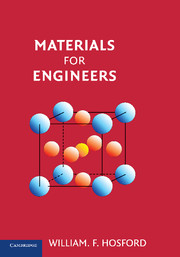Book contents
- Frontmatter
- Contents
- Preface
- 1 Introduction
- 2 Phases
- 3 Diffusion
- 4 Mechanical Behavior
- 5 Mechanical Failure
- 6 Annealing
- 7 Iron and Steel
- 8 Nonferrous Metals
- 9 Casting and Welding
- 10 Solid Shaping
- 11 Polymers
- 12 Polymer Processing
- 13 Glasses
- 14 Crystalline Ceramics
- 15 Powder Processing
- 16 Pottery and Concrete
- 17 Composites
- 18 Carbon
- 19 Fibers, Foams, and Porous Materials
- 20 Electrical Properties
- 21 Optical and Thermal Properties
- 22 Magnetic Materials
- 23 Corrosion
- 24 Modern Manufacturing Techniques, Surface Treatments, and Recycling
- APPENDIX 1 Wood
- APPENDIX 2 Miller Indices for Planes and Directions
- APPENDIX 3 X-ray Diffraction
- APPENDIX 4 Surfaces
- APPENDIX 5 Dislocations
- APPENDIX 6 Avrami Kinetics
- APPENDIX 7 Organic Chemistry
- APPENDIX 8 Average Molecular Weight
- APPENDIX 9 Bond Geometry in Compounds
- APPENDIX 10 Weibull Analysis
- Index
- Conversions
18 - Carbon
Published online by Cambridge University Press: 05 June 2012
- Frontmatter
- Contents
- Preface
- 1 Introduction
- 2 Phases
- 3 Diffusion
- 4 Mechanical Behavior
- 5 Mechanical Failure
- 6 Annealing
- 7 Iron and Steel
- 8 Nonferrous Metals
- 9 Casting and Welding
- 10 Solid Shaping
- 11 Polymers
- 12 Polymer Processing
- 13 Glasses
- 14 Crystalline Ceramics
- 15 Powder Processing
- 16 Pottery and Concrete
- 17 Composites
- 18 Carbon
- 19 Fibers, Foams, and Porous Materials
- 20 Electrical Properties
- 21 Optical and Thermal Properties
- 22 Magnetic Materials
- 23 Corrosion
- 24 Modern Manufacturing Techniques, Surface Treatments, and Recycling
- APPENDIX 1 Wood
- APPENDIX 2 Miller Indices for Planes and Directions
- APPENDIX 3 X-ray Diffraction
- APPENDIX 4 Surfaces
- APPENDIX 5 Dislocations
- APPENDIX 6 Avrami Kinetics
- APPENDIX 7 Organic Chemistry
- APPENDIX 8 Average Molecular Weight
- APPENDIX 9 Bond Geometry in Compounds
- APPENDIX 10 Weibull Analysis
- Index
- Conversions
Summary
Carbon can occur in several different forms including diamond, graphite, amorphous carbon, and fullerenes. None of these forms fit into the classification of materials as metals, ceramics, or polymers. Figure 18.1 shows the equilibrium between graphite, diamond, and liquid.
Diamond
Each carbon atom in diamond is covalently bonded to four other carbon atoms as shown in Figure 18.2. Very strong bonding makes diamond the hardest material known (10,000 kg/mm2). Diamond is used for cutting very hard materials. Diamond has an extremely high Young's modulus (1,050 GPa) and a very low coefficient of thermal expansion (1 × 10−6/K). It has the highest thermal conductivity of all materials (2 kW/m-K compared with 401W/m-K for copper), making it useful for dissipating heat. Its density (3.52 Mg/m3) is considerably greater than that of graphite (2.25 Mg/m3).
The first synthetic diamonds were made by subjecting carbon to very high pressures at high temperatures. Diamond can also be grown by chemical vapor deposition (CVD) under low pressure (1 to 27 kPa). Gasses include a carbon source and typically hydrogen heated in a pressurized chamber and broken down, depositing diamond on exposed surfaces. Large areas (> 150 mm2) can be coated on a substrate. This allows CVD diamond films to be used as heat sinks in electronics and to be used in wear-resistant surfaces.
Graphite
The structure of graphite consists of sheets of carbon atoms arranged in a hexagonal pattern (Figure 18.3). The bonding in the hexagonal sheets is like that in a benzene ring.
- Type
- Chapter
- Information
- Materials for Engineers , pp. 178 - 183Publisher: Cambridge University PressPrint publication year: 2008



